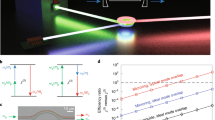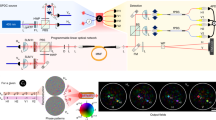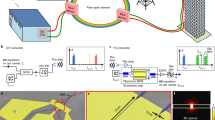Abstract
At present, wavelength-division-multiplexed fibre lines routinely operate at 10 Gbit s−1 per channel. The transition from static-path networks to true all-optical networks encompassing many nodes, in which channels are added/dropped and efficiently reassigned, will require improved tools for all-optical wavelength shifting. Specifically, one must be able to shift the carrier wavelength (frequency) of an optical data signal over tens of nanometres (a THz range) without the bottleneck of electrical conversion. Popular approaches to this problem make use of the nonlinear interaction between two wavelengths within a semiconductor optical amplifier1 whereas more novel methods invoke terahertz-frequency electro–optic modulation2 and polaritons3. Here we outline the principles and demonstrate the use of optically excited plasmons as a tunable frequency source that can be mixed with a laser frequency through Raman scattering. The scheme is all-optical and enables dynamical control of the output carrier wavelength simply by varying the power of a control laser.
This is a preview of subscription content, access via your institution
Access options
Subscribe to this journal
Receive 12 print issues and online access
$209.00 per year
only $17.42 per issue
Buy this article
- Purchase on Springer Link
- Instant access to full article PDF
Prices may be subject to local taxes which are calculated during checkout




Similar content being viewed by others
References
Campi, D. & Coriasso, C. Wavelength conversion technologies. Photon. Network Commun. 2, 85–95 (2000).
Su, M. Y., Carter, S. G., Sherwin, M. S., Huntington, A. & Coldren, L. A. Voltage-controlled wavelength conversion by terahertz electro-optic modulation in double quantum wells. Appl. Phys. Lett. 81, 1564–1566 (2002).
Nelson, K. A. Dynamic wavelength shifting method. US patent 6,717,717 (2004).
Oberson, P., Huttner, B. & Gisin, N. Frequency modulation via the Doppler effect in optical fibers. Opt. Lett. 24, 451–453 (1999).
Preble, S. F., Xu, Q. & Lipson, M. Changing the colour of light in a silicon resonator. Nature Photon. 1, 293–296 (2007).
Jalali, B., Raghunathan, V., Dimitropoulos, D. & Boyraz, Ö. Raman-based silicon photonics. IEEE J. Sel. Top. Quant. Electron. 12, 412–421 (2006).
Mooradian, A. & White, G. B. Observation of the interaction of plasmons with longitudinal optical phonons in GaAs. Phys. Rev. Lett. 16, 999–1001 (1966).
Mooradian, A. & McWhorter, A. L. Polarization and intensity of Raman scattering from plasmons and phonons in gallium arsenide. Phys. Rev. Lett. 19, 849–852 (1967).
Pinczuk, A., Shah, J. & Wolff, P. A. Collective modes of photoexcited electron–hole plasmas in GaAs. Phys. Rev. Lett. 47, 1487–1490 (1981).
Galbraith, I., Dawson, P. & Foxon, C. T. Optical nonlinearities in mixed type I – type II GaAs/AlAs multiple quantum wells. Phys. Rev. B 45, 13499–13508 (1992).
Guliamov, R., Lifshitz, E., Cohen, E., Ron, A. & Pfeiffer, L. N. Indirect barrier electron–hole gas transitions in mixed type-I–type-II GaAs/AlAs multiple quantum wells. Phys. Rev B 64, 035314 (2001).
Burstein, E., Pinczuk, A. & Mills, D. L. Inelastic light scattering by charge carrier excitations in two-dimensional plasmas: theoretical considerations. Surf. Sci. 98, 451–468 (1980).
Pinczuk, A. & Abstreiter, G. in Topics in Applied Physics 66, Light Scattering in Solids V (ed. Cardona, M. & Güntherodt, G.) 174–176 (Springer, Berlin, 1989).
Pinczuk, A. et al. Large exchange interactions in the electron gas of GaAs quantum wells. Phys. Rev. Lett. 63, 1633–1636 (1989).
Galbraith, I., Dawson, P. & Foxon, C. T. Optical nonlinearities in mixed type I – type II GaAs/AlAs multiple quantum wells. Phys. Rev. B 45, 13499–13508 (1992).
Rickter, W. in Springer Tracts in Modern Physics 78, Solid State Physics (ed. Höhler, G.) 121–272 (Springer, New York, 1976).
Fainstein, A., Jusserand, B. & Theirry-Mieg, V. Raman scattering enhancement by optical confinement in a semiconductor planar microcavity. Phys. Rev. Lett. 75, 3764–3767 (1995).
Vörös, Z., Balili, R., Snoke, D. W., Pfeiffer, L. & West, K. Long-distance diffusion of excitons in double quantum well structures. Phys. Rev. Lett. 94, 226401 (2005).
Ludwig, R. & Rabon, G. BER measurements of frequency converted signals using four-wave mixing in a semiconductor laser amplifier at 1, 2.5, 5 and 10 Gbit.s. Electron. Lett. 30, 338–339 (1994).
Jinno, M., Miyamoto, Y. & Hibino, Y. Optical-transport networks in 2015. Nature Photon. 1, 157–159 (2007).
O'Dowd, R. et al. Transmitters for two-tier optical data-packet labeling in advanced IP networks. IEE Proc. Optoelectron. 152, 163–169 (2005).
Liu, J. T. C., Jeffries, J. B. & Hanson, R. K. Wavelength modulation absorption spectroscopy with 2f detection using multiplexed diode lasers for rapid temperature measurements in gaseous flows. Appl. Phys. B 78, 503–511 (2004).
Zheng, J. Analysis of optical frequency-modulated continuous-wave interference. Appl. Opt. 43, 4189–4198 (2004).
Manassen, A., Cohen, E., Ron, A., Linder, E. & Pfeiffer, L. N. Exciton and trion spectral line shape in the presence of an electron gas in GaAs/AlAs quantum wells. Phys. Rev. B 54, 10609–10613 (1996).
Acknowledgements
We thank E. Cohen for supplying us with the MTQW samples used earlier in his studies. This research is supported by the US Department of Energy Office of Science, Basic Energy Sciences under contract numbers DE-AC36-83CH10093 and DE-FG02-99ER45780.
Author information
Authors and Affiliations
Corresponding author
Rights and permissions
About this article
Cite this article
Fluegel, B., Mascarenhas, A., Snoke, D. et al. Plasmonic all-optical tunable wavelength shifter. Nature Photon 1, 701–703 (2007). https://doi.org/10.1038/nphoton.2007.229
Received:
Accepted:
Published:
Issue Date:
DOI: https://doi.org/10.1038/nphoton.2007.229
This article is cited by
-
An all optical approach for comprehensive in-operando analysis of radiative and nonradiative recombination processes in GaAs double heterostructures
Light: Science & Applications (2022)
-
Overcoming diffusion-related limitations in semiconductor defect imaging with phonon-plasmon-coupled mode Raman scattering
Light: Science & Applications (2018)
-
Graphene-plasmon polaritons: From fundamental properties to potential applications
Frontiers of Physics (2016)
-
A shifting perspective
Nature Photonics (2007)



